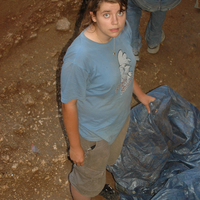
Michael brandl
I am a lithic raw material scientist and coordinator of the Lithic Lab at the Austrian Archaeological Institute of the Austrian Academy of Sciences (OeAW). My primary objectives are provenance studies of lithic raw materials used in prehistoric and historic contexts and the application of the results to resource management strategies. My main research areas are Europe and Western Asia. The method I use for my studies is called the Maulti Layered Chert Sourcing Approach, applying micropalaeontology, petrology, and geochemistry. For my geochemical approach, I use Laser Ablation Inductively Coupled Mass Spectrometry (LA-ICP-MS) for trace element analysis.
less
Related Authors
Philip R Nigst
University of Vienna
Hermann Prossinger
University of Vienna
Viola C. Schmid
Austrian Academy of Sciences
Luc Moreau
University of Cambridge
Nicolas Teyssandier
Université Toulouse II Jean Jaurès
Olaf Jöris
Leibniz-Zentrum für Archäologie
Florian Fladerer
Austrian Academy of Sciences
Tomáš Michalík
Independent Researcher
Marjolein Bosch
Austrian Academy of Sciences
Flora C Schilt
Vrije Universiteit Amsterdam
InterestsView All (16)









Uploads
Papers by Michael brandl
http://journals.ed.ac.uk/lithicstudies/article/view/3093
The focus of this paper are the stone tools of Çukuriçi Höyük, a prehistoric site situated at the central Aegean coast of Anatolia. The settlement was inhabited from the Neolithic, through the Late Chalcolithic and Early Bronze Age 1 periods, a period lasting from the early 7th to the early 3rd millennium BCE. A long-term interdisciplinary study of the excavated lithics with different scientific methods on various stone materials (thin section analysis, pXRF, NAA, LA-ICP-MS) offer new primary data about the procurement strategies of prehistoric societies from a diachronic perspective. The results will be presented for the first time with an overview of all source materials and their distinct use through time.
The lithic assemblages from Çukuriçi Höyük consist of a considerable variety of small finds, grinding stones and chipped stone tools. The high variability of raw materials within the different categories of tools is remarkable. In addition to stone tools manufactured from sources in the immediate vicinity of the settlement (i.e., mica-schist, limestone, marble, amphibolite, serpentinite), others are of rock types such as chert, which indicate an origin within the broader region. Moreover, volcanic rocks, notably the exceptionally high amount of Melian obsidian found at Çukuriçi Höyük, attest to the supra-regional procurement of distinct rock types. Small stone axes made of jadeite presumably from the Greek island of Syros, also indicate these far-reaching procurement strategies.
The systematic and diachronic analyses of the stone tools found at Çukuriçi Höyük has demonstrated that as early as the Neolithic period extensive efforts were made to supply the settlement with carefully selected raw materials or finished goods procured from distinct rock sources.
Die Rohstoffversorgung mit Silex und Bergkristall als idealer Werkstoff für
die Produktion von Steingeräten war für die Menschen der Steinzeit eine
wichtige Maßnahme. Es ging um die Erschließung von Ressourcen, Abbau,
Förderung und Distribution. Von Bedeutung waren Qualität und Quantität
des Materials. Zu den prospektierten Regionen gehören sowohl die nördlichen
und südlichen Kalkalpen als auch die kristalline Zone der Ostalpen.
Aktuelle montanarchäologische Untersuchungen in den letzten Jahren erbrachten
neue Forschungsergebnisse. War bis dato das Radiolaritbergwerk
von Mauer bei Wien der einzige Nachweis einer steinzeitlichen Abbaustelle
in Österreich, so konnten in den Jahren 2004 bis 2012 nicht weniger als
fünf weitere entsprechende Plätze in Vorarlberg, Tirol und der Steiermark
lokalisiert werden. Dabei stellte sich heraus, dass die daraus gewonnenen
Rohmaterialien überwiegend der regionalen Versorgung dienten.
Summary
Stone Age humans were highly reliant on access to chert and quartz as
ideal raw materials for the production of stone tools. They had to fi nd,
mine and distribute these materials, with both quality and quantity being
of great importance. Prospecting was carried out in the northern and
southern Limestone Alps as well as in the crystalline zone of the Eastern
Alps. Archaeological research carried out in the past few years has given us
new insights into mining during this period. Until recently the radiolarite mining site in Mauer near Vienna was the only proof of Stone Age mining
in Austria. However, between 2004 and 2012 fi ve previously unknown
sites were found in Vorarlberg, the Tyrol and Styria. Further investigations
revealed that the raw material mined at these sites was primarily used to
supply the local region.
http://journals.ed.ac.uk/lithicstudies/article/view/3093
The focus of this paper are the stone tools of Çukuriçi Höyük, a prehistoric site situated at the central Aegean coast of Anatolia. The settlement was inhabited from the Neolithic, through the Late Chalcolithic and Early Bronze Age 1 periods, a period lasting from the early 7th to the early 3rd millennium BCE. A long-term interdisciplinary study of the excavated lithics with different scientific methods on various stone materials (thin section analysis, pXRF, NAA, LA-ICP-MS) offer new primary data about the procurement strategies of prehistoric societies from a diachronic perspective. The results will be presented for the first time with an overview of all source materials and their distinct use through time.
The lithic assemblages from Çukuriçi Höyük consist of a considerable variety of small finds, grinding stones and chipped stone tools. The high variability of raw materials within the different categories of tools is remarkable. In addition to stone tools manufactured from sources in the immediate vicinity of the settlement (i.e., mica-schist, limestone, marble, amphibolite, serpentinite), others are of rock types such as chert, which indicate an origin within the broader region. Moreover, volcanic rocks, notably the exceptionally high amount of Melian obsidian found at Çukuriçi Höyük, attest to the supra-regional procurement of distinct rock types. Small stone axes made of jadeite presumably from the Greek island of Syros, also indicate these far-reaching procurement strategies.
The systematic and diachronic analyses of the stone tools found at Çukuriçi Höyük has demonstrated that as early as the Neolithic period extensive efforts were made to supply the settlement with carefully selected raw materials or finished goods procured from distinct rock sources.
Die Rohstoffversorgung mit Silex und Bergkristall als idealer Werkstoff für
die Produktion von Steingeräten war für die Menschen der Steinzeit eine
wichtige Maßnahme. Es ging um die Erschließung von Ressourcen, Abbau,
Förderung und Distribution. Von Bedeutung waren Qualität und Quantität
des Materials. Zu den prospektierten Regionen gehören sowohl die nördlichen
und südlichen Kalkalpen als auch die kristalline Zone der Ostalpen.
Aktuelle montanarchäologische Untersuchungen in den letzten Jahren erbrachten
neue Forschungsergebnisse. War bis dato das Radiolaritbergwerk
von Mauer bei Wien der einzige Nachweis einer steinzeitlichen Abbaustelle
in Österreich, so konnten in den Jahren 2004 bis 2012 nicht weniger als
fünf weitere entsprechende Plätze in Vorarlberg, Tirol und der Steiermark
lokalisiert werden. Dabei stellte sich heraus, dass die daraus gewonnenen
Rohmaterialien überwiegend der regionalen Versorgung dienten.
Summary
Stone Age humans were highly reliant on access to chert and quartz as
ideal raw materials for the production of stone tools. They had to fi nd,
mine and distribute these materials, with both quality and quantity being
of great importance. Prospecting was carried out in the northern and
southern Limestone Alps as well as in the crystalline zone of the Eastern
Alps. Archaeological research carried out in the past few years has given us
new insights into mining during this period. Until recently the radiolarite mining site in Mauer near Vienna was the only proof of Stone Age mining
in Austria. However, between 2004 and 2012 fi ve previously unknown
sites were found in Vorarlberg, the Tyrol and Styria. Further investigations
revealed that the raw material mined at these sites was primarily used to
supply the local region.
public and scientific perception of archaeological research in the region.